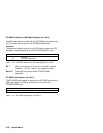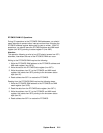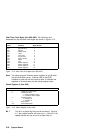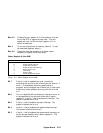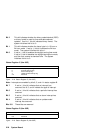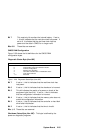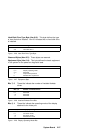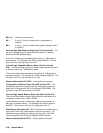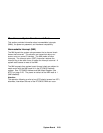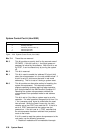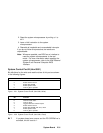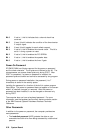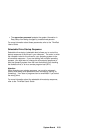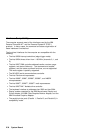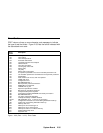Bits 3–2 These bits are reserved.
Bit 1 If set to 1, this bit indicates that a coprocessor is
installed.
Bit 0 If set to 1, this bit indicates that physical diskette drive 0
is installed.
Low and High Base Memory Bytes (Hex 015 and Hex 016):
The
low and high base memory bytes define the amount of memory
below the 640 KB address space.
The value in these bytes represents the number of 1 KB blocks of
base memory. For example, hex 0280 indicates 640 KB. The low
byte is hex 015; the high byte is hex 016.
Low and High Expansion Memory Bytes (Hex 017 and Hex
018):
The low and high expansion memory bytes define the amount
of memory above the 1 MB address space.
The value in these bytes represents the number of 1 KB blocks of
expansion memory. For example, hex 0800 indicates 2048 KB. The
low byte is hex 017; the high byte is hex 018.
Reserved Bytes (Hex 01D–02D):
These bytes are reserved.
Configuration Checksum Bytes (Hex 02E and Hex 02F):
The
configuration checksum bytes contain the checksum character for
bytes hex 010 through hex 02D of the 64-byte CMOS RAM. The
high byte is hex 02E; the low byte is hex 02F.
Low and High Usable Memory Bytes (Hex 030 and Hex 031):
The low and high usable memory bytes define the total amount of
contiguous memory from 1 MB to 20 MB.
The hexadecimal values in these bytes represent the number of 1
KB blocks of usable memory. For example, hex 0800 is equal to
2048 KB. The low byte is hex 30; the high byte is hex 31.
Date-Century Byte (Hex 032):
Bits 7 through 0 of the date-century
byte contain the binary-coded decimal value for the century. For
information about reading and setting this byte, refer to the
IBM
Personal System/2 and Personal Computer BIOS Interface
.
Reserved Bytes (Hex 033–07F):
These bytes are reserved.
2-28 System Board



